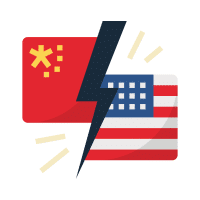Remembering Joseph Fewsmith: The Passing of a Generation of China Hands
Robotic Might, Aerospace Fright: China’s Uneven March to Tech Sovereignty
- Analysis
 China-Focus-Editor
China-Focus-Editor- 08/13/2025
- 0

Source: Nvidia website
[The China Focus at The Carter Center, in cooperation with the China Focus at the University of California, San Diego, and the 1990 Institute, organized an essay contest in honor of President Jimmy Carter. This essay, by Pablo Dufour of The London School of Economics and Political Science (LSE), received The 1990 Institute Prize. Read more HERE.]
In 2015, China made a promise to itself that the rest of the world could not afford to ignore. The launch of ‘Made in China 2025’ (MIC2025) identified ten strategic sectors in which China sought to boost its global competitiveness and ascend as a leading manufacturing power. MIC2025 was more than an industrial strategy; it was a national manifesto to transform the country from ‘the world’s factory’ into a technological powerhouse. Ten years on, it’s time to ask if China has achieved what it set out to do. This essay zeroes in on two particularly illustrative sectors, robotics and aerospace, to assess both the triumphs and the turbulence of China’s quest for technological leadership. It argues that in robotics, China has turned scale and statecraft into decentralized market power, dominating global mid-tier segments and redefining what industrial success looks like. Aerospace, however, exposes the inertia of dependency, where Chinese ambitions of sovereignty remain hamstrung by foreign components and certification bottlenecks. Together, these sectors offer a revealing lens into China’s techno-political future of self-reliance: a state caught between what it can build and what it cannot yet own.
Mid-Tier, Max Power: How China Reprogrammed the Robotics Race
Among the industries prioritized by MIC2025, robotics stood out not only as a litmus test of China’s industrial maturity but as a proxy for its wider push toward technological self-sufficiency. In 2014, China was already the world’s largest buyer of industrial robots (Powley 2014), yet the paradox was glaring: China was dependent on imports for high-precision equipment, core components, and software, especially from Japan, Germany, and the U.S. The MIC2025 plan aimed to end that dependency. A specific and audacious target was set, namely that by 2025, 70 percent of domestically sold industrial robots should be manufactured by Chinese firms (Jourdan et al. 2018). As we arrive in 2025, the evidence suggests not only that China has come remarkably close to fulfilling this goal, but that it has reshaped the global robotics hierarchy in the process.
According to the U.S.-China Economic and Security Review Commission (2025), China now installs more than half of the world’s industrial robots, a striking rise from just 14 percent ten years ago. Fast-growing segments like SCARA (Selective Compliance Assembly Robot Arm) and collaborative robots (cobots) were achieved through a confluence of targeted subsidies and procurement incentives that fostered rapid scaling. Firms like Estun, Efort, and Siasun have emerged as increasingly credible challengers to Western incumbents. According to the president of the International Federation of Robotics (IFR), China has overtaken Germany in robot density and now holds the third-highest position globally, following South Korea and Japan (International Federation of Robotics 2024). This marks a remarkable shift, especially considering China only entered the global top ten in 2019
(Handelsblatt 2024). Through the Belt and Road Initiative (BRI), China has internationalized its robotics ambitions, moving from automation follower to global frontrunner. As Andreoni et al. (2024) observe, the BRI has been reoriented to serve as a platform for expanding market access for Chinese robotics firms, drawing in capital for technological upgrades and shaping industry standards. Therefore, MIC2025 transformed robotics from a sectoral success story into a geopolitical tool through which China exports not only machines but also influence.
Beyond international market penetration, China’s internal landscape of automation has been radically transformed. The emergence of highly digitized and automated production facilities (‘lighthouse factories’) underscores this evolution. Around 41 percent of all global lighthouse factories are located in China (World Economic Forum 2025), seamlessly integrating AI, IoT, robotics, and big data analytics. Regional dynamics also reveal how China translated national ambitions into geographically distributed execution. Andreoni et al. (2024) identify four major robotics hubs: Guangdong, the Yangtze River Delta, the Beijing-Tianjin corridor, and the Jilin-Liaoning cluster. These regions functioned as techno-industrial ecosystems, characterized by dense supplier networks with university-industry collaborations and tiered government support. This multiscalar implementation of MIC2025 enabled the national objectives to be refracted into localized industrial strategies.
Critics, however, point to China’s persistent dependence on foreign suppliers for core components, such as control chips (Catarata et al. 2021). Indeed, in high-precision segments, Western firms like Fanuc, ABB, and KUKA still maintain a performance edge. This valid concern is, however, analytically insufficient. What many critics overlook is the strategic shift Chinese firms have made in balancing cost and performance. Instead of competing at the high end, they have engineered affordable robots with reliable and targeted functionality that capture a large share of the mid-range global market. While foreign competitors focus on perfecting high-end technologies, Chinese companies have carved out a strong position in markets where affordability and practicality carry more weight. As De la Bruyère (2025) puts it, this isn’t a step down, but a conscious move to align with the real needs of emerging economies.
Thus, the question remains: Is perfection necessary for dominance? China has arguably reshaped the global robotics landscape by flooding mid-tier markets with affordable and functional solutions, pushing competitors to innovate or retreat. China may not yet rival Germany or Japan in ultra-high precision robotic arms, but it has redefined what success in robotics means: affordable, scalable, and exportable solutions, backed by a strategic industrial policy that fuses domestic upgrading with international outreach. In doing so, China has not only fulfilled the central aims of MIC2025 but has redefined the global robotics market on its own terms.
Flying on Borrowed Wings: The C919 and China’s Aerospace Illusion
Where MIC2025 projects power through robotics, it exposes fragility through aerospace, or more specifically, the aviation sector. The ambition was unmistakable: build a domestically developed commercial aircraft that could challenge the Boeing-Airbus duopoly and symbolize technological independence by elevating China’s industrial status to that of a global innovator. That ambition materialized in the form of the C919 jet, developed by the Commercial Aircraft Corporation of China (COMAC). But as of 2025, the C919 stands less as a symbol of self-reliance and more as a deeply international aircraft in Chinese livery. In robotics, China can rely on foreign components because the industry allows for flexibility and rapid growth, with companies focusing on affordable products for emerging markets. In contrast, the aerospace industry demands tightly integrated systems and compliance with rigorous international safety standards (Kunze et al. 2018), making foreign dependence a structural limitation that significantly undermines China’s ability to achieve technological sovereignty.
In a 2020 report, the Center for Strategic and International Studies (CSIS) estimated that nearly 90 percent of the major component suppliers for the C919 aircraft were based in North America and Europe, while just 10 percent originated from China and other parts of Asia (Kennedy 2020). Critical components such as flight control and navigation systems remain sourced from Western suppliers like Parker Aerospace or Rockwell Collins. Meanwhile, supporters of MIC2025 frequently point to the development of a domestic supply chain ecosystem as evidence of meaningful progress. COMAC, for instance, has established partnerships with local suppliers, and China is heavily investing in developing indigenous alternatives (COMAC 2025). However, these domestically produced components are not expected to be certified before 2030. Technical benchmarks remain unmet as Chinese suppliers still lag in producing advanced composites with the durability-to-weight ratios required for international competitiveness (Bork 2024; Risseeuw et al. 2024). Moreover, the aviation sector is plagued by structural inefficiencies that have no analog in China’s more agile industries, such as robotics. China’s aerospace governance is fragmented, with overlapping bureaucracies between COMAC, AVIC (Aviation Industry Corporation of China), and numerous provincial and national regulators (Risseeuw et al. 2024). As a result, the current generation of C919 aircraft will remain fully reliant on foreign engines throughout the remainder of the decade. In international markets, the aircraft has struggled to gain traction due to its non-compliance with Federal Aviation Administration (FAA) certifications, making meaningful export ambitions currently unattainable. The actual deployment of C919s with China Eastern Airlines has been commercially limited, making it more politically symbolic than economically transformative and thus rather serving as a symbol of national ambition than a disruption to the global aviation landscape.
That said, China’s efforts are not futile. The C919 is a foundation, and the ongoing development of domestic alternatives signals strategic patience. The aerospace vision extends beyond MIC2025 to 2035 and 2050, with long-term investments in technology parks like the Zhangjiang Aviation Innovation Zone in Shanghai. However, the very extension of timelines underscores the central failure of MIC2025 in this domain: the target was not merely long-term ambition but significant technological independence by 2025. That target has not been met.
China’s aerospace industry is thus caught in a paradox, as it is at once one of the most symbolically important and yet least self-sufficient sectors within MIC2025. In short, the C919 is not yet the ‘Chinese Airbus’ it was touted to become. It is an assemblage of imported technologies, wrapped in the flag of industrial sovereignty but flying on borrowed wings.
Blueprints or Bottlenecks? China’s Next Leap in the Innovation Game
As China confronts the edge of its MIC2025 ambitions, the implications for its technological future are both promising and paradoxical. The uneven success across sectors like robotics and aerospace reveals that China is not confronting a singular technology gap, but rather a mosaic of institutional, strategic, and geopolitical dilemmas. These dilemmas will not be resolved by simply extending current policy instruments, but by fundamentally reconfiguring the architecture through which innovation is governed.
Firstly, one of the most urgent implications lies in China’s governance of innovation ecosystems. While the MIC2025 period demonstrated China’s unmatched capacity for mobilizing capital and aligning state priorities, it has also exposed a persistent deficit in systemic coherence, as innovation capacity is uneven across sectors and institutional architectures. In long-cycle and integration-heavy sectors like aerospace, innovation has stagnated due to fragmented institutional linkages and insufficient mechanisms for iterative coordination. Clarke et al. (2018) argue that as states approach the technological frontier, they must develop institutional systems where sectors like education, research, and legal frameworks are tightly coordinated to sustain innovation. Without this institutional scaffolding, technological progress is likely to remain siloed and sectorally uneven. In robotics, China’s success hinged on decentralization: regional clusters and localized university-industry partnerships created vibrant feedback loops that scaled quickly. In contrast, the aerospace sector remains dominated by top-down hierarchies and bureaucratic fragmentation. The contrast exemplifies what Peter Evans (1995: 12) termed the need for “embedded autonomy” — a delicate balance where the state is sufficiently insulated to act strategically, yet deeply networked with technical communities to stay responsive. China’s 15th Five-Year Plan’s (2026-2030) rumored pivot toward platform-based
governance, where innovation platforms operate with autonomy, may signal that China has begun internalizing this lesson.
But institutional reform alone will not be enough. The second major implication is China’s navigation of the paradox between open and indigenous innovation. The MIC2025 period unfolded in a geopolitical environment increasingly hostile to technology transfer, with growing export controls and tightened investment scrutiny from the U.S. and EU. Due to China’s limited and politically charged integration into global innovation networks, China has adopted what could be described as a strategy of strategic duality: aggressively building domestic capability while opportunistically absorbing foreign knowledge through mergers and reverse engineering (Fu et al. 2021). But this dual approach is reaching diminishing returns. As key countries wall off dual-use and foundational technologies, particularly in avionics, the cost of technological decoupling will grow (Fu et al. 2021). A future-proof strategy will require building mechanisms to sustain innovation independently through robust IP systems, high-trust university-industry linkages, and venture ecosystems that reward experimentation, not just replication. Nowhere is this tension more acute than in dual-use technologies (Fu et al. 2021). During the MIC2025 era, sectors like robotics quietly became incubators for military-relevant technologies. Going forward, this dynamic is unlikely to remain peripheral. Under the emerging ‘New Quality Productive Forces’ paradigm, coined by Xi Jinping, the line between civil and defense technologies is blurring, with national security increasingly becoming the central logic of industrial policy (Fu et al. 2021). Therefore, dual-use investment channels will accelerate technological diffusion between the civil and defense sectors.
Ultimately, MIC2025 was never just a plan, it was a diagnostic. The next frontier of technological development will be determined not by subsidies or slogans, but by China’s ability to develop so-called mission-driven ecosystems, where state guidance, private initiative, and academic discovery coalesce around shared long-term goals. The next decade will thus likely feature post-linear innovation, where breakthroughs emerge from the ability to maneuver within, around, and against a fragmented global ecosystem.
For China, this means embracing asymmetry as a strategy: dominate where possible, decouple where necessary, and innovate where the rules can be rewritten. Whether this next chapter brings technological parity or merely strategic parity remains to be seen. As we step beyond 2025, the question is no longer whether China can build. It can. The question is whether it can coordinate across sectors and institutions over time to convert technological ambition into sustained, self-directed innovation. That answer will determine whether the next C919 will fly on borrowed wings or on China’s own.
Conclusion
What happens when the world’s largest factory decides it no longer wants to just assemble the future, but design it? The answer, as revealed through MIC2025, lies in the tension between sectoral acceleration and structural inertia. China’s capacity to scale, adapt, and dominate robotics middle-market niches has redefined global competition, not by beating the West at its own game, but by changing the rules. The sector’s rapid ascent reflects the power of coordinated industrial policy in localized innovation ecosystems. Yet in aerospace, we see the outer limits of that model, where centralized ambition runs into the hard constraints of fragmented governance and technological dependency. The disparate outcome of robotics and aerospace under MIC2025 is not merely an artifact of sectoral complexity but reveals the institutional boundaries of China’s model of technological upgrading. China’s quest for innovation sovereignty is thus neither a clear triumph nor an outright failure, but a recalibration of what technological success looks like in the 21st century. What began as a domestic modernization blueprint has evolved into a global strategic concern, answered by assertive international responses such as the U.S. CHIPS and Science Act, Japan’s export controls, and Europe’s assertive industrial policy. Looking ahead, the question is not whether China will catch up. It will and in many domains, already has. The more urgent question is whether it can build institutional depth and adaptive ecosystems to sustain innovation over decades. MIC2025 was the opening move in a longer flight, and whilst the plane may still be on the runway, the direction of flight is unmistakable.
Bibliography
Andreoni, A., Frattini, F., Prodi, G. (2024). Getting robots in ‘our own hands’: Structural drivers, spatial dynamics and multi-scalar industrial policy in China. Competition & Change, 0(0).
Bork, H. (2024, November 21). Wie erfolgreich war „Made in China 2025“? MM Maschinenmarkt. https://www.maschinenmarkt.vogel.de/china-erreicht-ziele-made-in-china-2025-a-0b70e7da146 fe4bf3d6df597bb4170b4/.
Catarata, M., Heide, F., Herrmann, M., Jeske, B., Kinzius, L., Wübbeke, J. (2021). Markt China im Wandel Wie bleibt der Maschinenbau im Wettbewerb erfolgreich?. VDMA/Swissmem.
Clarke, T., Chelliah, J., Pattinson, E. (2018). National Innovation Systems in the Asia Pacific: A Comparative Analysis. In T. Clarke & K. Lee (Eds.), Innovation in the Asia Pacific. Springer, p. 119–143.
COMAC (2025). Commitment to Collaborative Excellence. https://comac.co.id/partnership/.
De La Bruyère, E. (2025, February 6). Made in China 2025—Who is winning? Testimony before the U.S.-China Economic and Security Review Commission. Foundation for Defense of Democracies. https://www.fdd.org/analysis/2025/02/06/made-in-china-2025-who-is-winning/.
Evans, P. (1995). Embedded Autonomy: States and Industrial Transformation. Princeton University Press.
Fu, X., McKern, B., Chen, J., Yin, X. (2021). ‘Conclusion: Innovation in China: Past, Present, and Future Prospects’. In: Fu, X., McKern, B., Chen, J. (eds), The Oxford Handbook of China Innovation (2021). Oxford University Press, p. 735–758.
Handelsblatt (2024, November 20). China überholt Deutschland bei Roboter-Dichte in der Industrie. https://www.handelsblatt.com/unternehmen/industrie/roboter-dichte-in-der-industrie-china-uebe rholt-deutschland/100089638.html.
International Federation of Robotics (2024, November 20). Global Robot Density in Factories Doubled in Seven Years. https://ifr.org/ifr-press-releases/news/global-robot-density-in-factories-doubled-in-seven-years.
Jourdan, A., McClellan, P. (2018, April 20). Factbox: Made in China 2025: Beijing’s big ambitions from robots to chips. Reuters. https://www.reuters.com/article/us-usa-trade-china-policy-factbox/factbox-made-in-china-2025 -beijings-bigambitions-from-robots-to-chips-idUSKBN1HR1DK/.
Kennedy, S. (2020, December 7). China’s COMAC: An Aerospace Minor Leaguer. Center for Strategic and International Studies. https://www.csis.org/blogs/trustee-china-hand/chinas-comac-aerospace-minor-leaguer.
Kunze, F., Windels, T. (2018). »Made in China 2025«: Technologietransfer und Investitionen in ausländische Hochtechnologiefirmen – Chinas Weg zum Konkurrenten um die Zukunftstechnologien. IFO Schnelldienst, 71(14), p. 3–16.
Powley, T. (2014, June 1). China becomes largest buyer of industrial robots. Financial Times. https://www.ft.com/content/a5cca8c0-e70c-11e3-aa93-00144feabdc0.
Risseeuw, Z., Clarke, C., Nguyen, H., Tanveer, S. (2024). An analysis of the “Made in China 2025” initiative with U.S. Cyber Command (PREP Project Report). George Mason University, Costello College of Business.
U.S.-China Economic and Security Review Commission (2025, February 6). Hearing on Made in China 2025—Who is winning? Hearing before the U.S.-China Economic and Security Review Commission, One Hundred Nineteenth Congress, First Session.
World Economic Forum (2025). The Global Lighthouse Network is comprised of 189 Lighthouses. https://initiatives.weforum.org/global-lighthouse-network/lighthouses.




